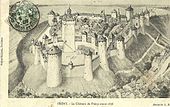Prény
| Prény | ||
|---|---|---|

|
|
|
| region | Grand Est | |
| Department | Meurthe-et-Moselle | |
| Arrondissement | Nancy | |
| Canton | Pont-à-Mousson | |
| Community association | Mad et Moselle | |
| Coordinates | 48 ° 59 ′ N , 6 ° 0 ′ E | |
| height | 185–378 m | |
| surface | 15.09 km 2 | |
| Residents | 355 (January 1, 2017) | |
| Population density | 24 inhabitants / km 2 | |
| Post Code | 54530 | |
| INSEE code | 54435 | |
 Prény - town view |
||
Prény is a place and a French commune ( commune ) with 355 inhabitants (as of January 1, 2017) in the Meurthe-et-Moselle department in the Grand Est region (until 2015 Lorraine ).
location
Prény is located on a hill two and a half kilometers east of the Moselle at an altitude of about 330 meters above sea level. d. M. and is about 24 kilometers (driving distance) in a south-westerly direction from the city of Metz ; the city of Nancy is about 43 kilometers southeast.
Population development
| year | 1962 | 1968 | 1975 | 1982 | 1990 | 1999 | 2006 | 2012 |
| Residents | 181 | 157 | 165 | 239 | 303 | 340 | 379 | 375 |
In the 19th century the population of the place was constant between about 350 and 420 people. After that, the number of residents slowly but steadily fell to the lows of the 1960s and 1970s, but the proximity to the city of Metz has resulted in a significant increase in recent years.
economy
In the Middle Ages, Prény was a rather insignificant village like others in the area. In the Middle Ages, the residents had to provide services for the lords of the castle and otherwise lived as self-sufficient farmers on the fields in the valley until the 20th century. Nowadays tourism plays a not insignificant role in the economic life of the place.
history
Archaeologists suspect that the striking and strategically important hill of Prény was crowned by a fortified settlement ( oppidum ) as early as in Celtic times . Only a few finds can be assigned to the Roman and Gallo-Roman times. The first written mention of the place comes from the year 960.
The Dukes of Lorraine built a castle complex ( château ) from the 10th century , which became their preferred residence in the 12th century, but was repeatedly besieged by the Counts of Bar , who finally took the fortress in 1207 and destroyed it. However, the complex was rebuilt and was able to withstand another siege by the Counts of Bar for five months in 1262. Further disputes between the conflicting parties and with the Dukes of Burgundy followed until the Duchy of Bar and the Duchy of Lorraine finally merged in the late 15th century under René d'Anjou and his grandson René II . Shortly before, Burgundy had been defeated with the help of the Confederates in the Battle of Nancy (January 5, 1477).
During the Thirty Years' War (1632) the Prény fortress was occupied by French troops and a few years later (1636) it was razed on the orders of Cardinal Richelieu , who feared that the Lorraine would regain strength. From then on, the fortress no longer played a strategic role. During the French Revolution it was sold as a national good ( Bien national ).
German troops captured Prény on September 5, 1914; They subsequently integrated the small town with its large fortress ruins into their defense system and surrounded it with several rifle positions as part of the 'block house' concept. From 1940 to 1944 Prény was reoccupied by the Wehrmacht .
Attractions

- The castle and castle buildings of the Château de Prény , which are still imposing as ruins , were built over a period of around five centuries and extend over an area of around 45,000 square meters; they were recognized as a monument historique in 1862 . Within the Mauergeviert you can still see remnants of residential developments and buildings used by the military; several chimneys have been preserved.
- The guard house ( corps de garde ) was built in the second half of the 13th century. The gate next to it ( porte des champs ) led to the fields in the valley.
- The Saint-Pierre church was built in 1824 but was thoroughly restored a hundred years later.
- On the outskirts there are two covered washing areas ( lavoirs ).
Personalities
- In April 1915, the German writer Ernst Jünger (1895–1998) briefly visited Prény, which he described in his main work In Stahlgewittern as a pretty mountain village, which is towered over by a ruined castle.
Web links
- Château de Prény - Photos + Info (Structurae, French)
- Château de Prény - photos + information (French)
- Castles and fortresses in Lorraine - photos, links + brief information (French)
Individual evidence
- ↑ Château, Prény in the Base Mérimée of the French Ministry of Culture (French)



